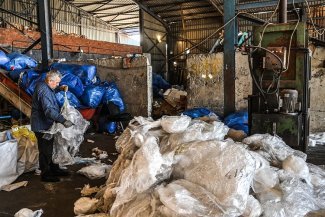The port of Marseille lies within the boundaries of the city. Concern is growing amongst local residents over its impact on their health.
Denis and Elisabeth Pelliccio like to reminisce about the days when they used to be able to swim between the ports of Joliette and Estaque in Marseille. It was a long time ago, before the 1950s, before a “huge mass of concrete took the sea away” from them. The huge mass of concrete was the Autonomous Port of Marseille, renamed the Grand Port Maritime de Marseille (GPMM) following a government reform in 2008. Residents of the 16th district of Marseille – one of those falling within the rough definition of the ill-famed ‘northern districts’ – the two pensioners, who have lived there for decades, have the feeling that “everything that isn’t wanted in the centre of Marseille is sent up here to our area”.
In addition to the eyesores, one of the main sources of anger amongst the Marseillais living near the port is the air pollution produced by the cruise liners, container ships and shipyards. The pollution itself is by no means new, but the issue only came into the public eye a few years ago. According to Dominique Robin, head of Air Paca, the organisation tasked with monitoring air quality in the region: “Awareness started to be raised with the growth in large cruise liner traffic. Their sheer size made the problem visible.” These floating mini-cities also sometimes dock for several days, keeping their engines running to supply the ship with electricity.
In Marseille, it was a study that brought the issue to public attention. In 2016, the French and German associations France Nature Environnement and NABU carried out air quality controls in various parts of the city. The results were alarming: compared with an average of 5,000 ultra-fine particles per cm³ in the city centre, the level rose to 60,000 p/cm³ in a residential district bordering the port, that is, 120 times higher, raising fears amongst locals.
“We have a lot of health problems here,” says Elisabeth Pelliccio. “There are children with brain tumours. There is also quite a lot of lung cancer. When it spits, it becomes unbreathable here.”
What is the impact, in concrete terms, of these shipping emissions on the health of the people living in the vicinity of the port? The scientific literature on the matter indicates that fine particles affect the respiratory system and are a cause of cancer or cardiovascular events. But according to Charles Chanut, a doctor who belongs to the Cap au Nord association, which is also committed to the issue: “No doctor is able to tell you with all certainty that a patient has such or such a disease because of the air pollution.”
Whilst it is difficult to establish the link between pollution and disease on a case-by-case basis, statistical studies, such as that published in June 2015 by the German University of Rostock and the Helmhotz Zentrum Munich research centre for environmental health, have drawn up estimates of the number of deaths specifically due to maritime pollution. They found that the figure was around 60,000 premature deaths, mainly caused by pulmonary or cardiovascular diseases.
A large ship pollutes as much as one million vehicles
What is it that makes the pollution from shipping particularly harmful? “The WHO [World Health Organization] has classified diesel particles as carcinogenic,” explains Robin. “The types of fuel used in marine transport, heavy fuel and marine diesel, emit particles that are known to be harmful.” The emissions released into the air through ships’ funnels include particularly high levels of nitrogen dioxide and sulphur dioxide, as well as fine and ultrafine particles.
The source of the problem lies in the vessels’ tanks. Heavy fuel oil is most commonly used in maritime transport. It is thick, cheap…and very polluting. At sea, the current limit on the sulphur content in the fuel used is 3.5 per cent for cargo ships and 1.5 per cent for cruise liners. For diesel cars, the ceiling is 0.001 per cent, that is, 3,500 and 1,500 times less. According to France Nature Environnement, a large ship pollutes as much as a million vehicles.
Although it is the huge cruise liners that have drawn public and media attention to the issue, they are not, in fact, the worst offenders in terms of harmful emissions. Denis Pelliccio, for example, points the finger at “the cargo ships and ferries” and highlights the efforts being made in the cruise ship sector: the use of “scrubbers” – stopping certain pollutants from being released into the atmosphere – or “LNG”, liquid natural gas, which releases virtually no fine particles, very low levels of nitrogen oxides, and 25 per cent less CO². In addition, on reaching the port, cruise ships, like all other vessels, have to switch to a fuel with less than 0.5 per cent sulphur content when docking for over two hours.
In Marseille, where the authorities hope to receive two million cruise passengers by 2020, shipowners are beginning to understand the business value of cleaner energy.
On 27 June 2018, port director Christine Cabau-Woerhel rewarded nine cruise line and container ship companies for their “willingness to go further than current regulations supporting sustainable development”. It is, above all, a “symbolic” gesture, confesses the port director, but one that “allows us to send out a message” to shipowners and give expression to “a fundamental shift”.
This greening strategy is being deployed, as the head of sustainable development at the port, Magali Deveze, explains, because port authorities do not have the power to establish binding measures, unlike the Department of Maritime Affairs (MAD), a French government agency, which has the authority to conduct random checks on whether the rules are being respected by ships’ crews. This is what happened on 29 March of this year, in the waters of Marseille, where Azura, a ship owned by Carnival PLC, was caught red handed with sulphur emissions of 1.68 per cent instead of the maximum of 1.5 per cent. For the first time in France, a ship’s captain will be tried on 8 October at the Magistrates’ Court of Marseille. He faces up to one year in prison and a €200,000 fine. It is a strong symbolic stand against air pollution, taken by the Public Prosecutor of the French Republic.
Changing international regulation
The body that dictates the rules for shipping, and therefore has more power to take action, is the International Maritime Organization (IMO). Responsible for three per cent of global CO² emissions, and yet absent from the commitments made during the COP21 in Paris, the maritime sector recently decided to cut CO² emissions by 50 per cent by 2050. With regards to sulphur emissions, all vessels, worldwide, will be under the obligation to use fuel with less than 0.5 per cent sulphur content as of 1 January 2020.
But the French government wants to go further, establishing a controlled emissions zone across the Mediterranean, limiting the sulphur content of fuels to 0.1 per cent, as is already the case in the Channel-North Sea-Baltic area. So why is the Mediterranean lagging behind? Damien Chevallier, assistant to the deputy director of maritime safety at the Ministry for the Ecological Transition, goes some way towards explaining: “Geopolitics is much simpler in the North. It’s more difficult to discuss issues in the Mediterranean, where there are not only Europeans.” To clarify, the states of northern Europe have been able to get a step ahead of the IMO rules thanks to an EU directive, something that is not possible in the Mediterranean, combining European, African and Middle Eastern waters.
To show all Mediterranean countries that pollution from shipping also affects their citizens and to convince them to take action in the same direction, France is taking the lead: “We are conducting a comprehensive study of the whole area, in partnership with other bodies, to track the emissions in the Mediterranean and their impact,” explains Chevallier. The findings will be presented to the IMO in October.
Very concerned about this issue, Saïd Ahamada, a parliamentary deputy representing constituents from the 15th and 16th districts of Marseille and a member of the Maritime Affairs Committee at the National Assembly, feels that things are going in the right direction: “All those I have seen from the sector are aware that we have to move towards better fuel.” Costa Cruises has, for example, already announced that its next two ships will be fuelled by LNG. The first should dock in Marseille as of 2019. CMA CGM, one of the world’s leading cargo and container shipping groups, headquartered in Marseille, has also committed to fuel its next nine container ships with this less polluting energy. Despite these good initiatives, the conversion is generally taking time. According to Christine Cabau-Woerhel, “A system needs to be put in place as of now.”
For technical reasons, however, the older vessels, mainly the roll-on-roll-off ships (that carry trucks) will not be able to convert to this energy. Installing scrubbers is the only way to reduce their pollution. As for the large numbers of ferries docking in Marseille, plugging in to the electricity supply at the port is a solution that is gaining traction. The ships owned by Méridionale, providing ferry services to Corsica and Italy, are already able to plug in at port and Corsica Linea ferries should be able to do the same in 2019, stopping them from having to leave their engines running.
Locals still concerned
Despite these measures, the residents of the northern districts fear they will continue to cough. Their fears are fuelled by plans to develop the port, which could mean more ferries serving north Africa, older and more polluting vessels, coming close to their doorsteps. The Pelliccios would like to see the Regional Health Agency conduct an epidemiological survey. “It’s complicated,” explains Robin, head of Air Paca, “Because of the statistical power needed to analyse the impacts of this pollution. But there would most certainly be enough data to use if taken from all the Mediterranean ports as a whole.” In Corsica, Nice and Toulon, associations are also mobilising around the issue.
In the meantime, the association in charge of monitoring air quality is working in partnership with the Environmental Chemistry Laboratory (LCE) of Marseille on a special programme in the northern districts to measure the impact of volatile organic compounds, and fine and ultrafine particles on the local population. “Next year, we’ll try to identify the levels produced by the different sources: transport, heating, industry,” adds Dominique Robin. Similar measures are being taken in Nice, a port city that is also concerned.
Initiatives are seemingly being taken on all fronts to tackle maritime air pollution. But between the time it will take ship owners to switch to cleaner energy, for international regulations to evolve, and new energy supply networks to be put in place, the wait is clearly too long for those living near the port. So they are calling for, at least, more dialogue with the GPMM. “We are worried,” says Denis Pelliccio. “Right now, we are not sure where we are going. We want a consultation framework, so that we know what the port wants to do rather than what it has decided to do.” In June, thanks to the mediation of Parliamentary Deputy Saïd Ahamada, the management of the GPMM agreed to meet with local residents every six months to discuss its projects. Perhaps it will be a chance for them to start seeing a little more clearly through the plumes of smoke.











